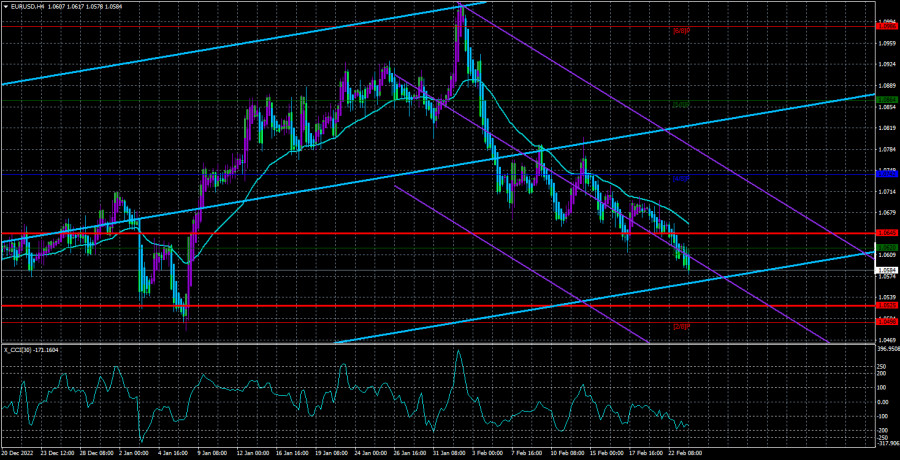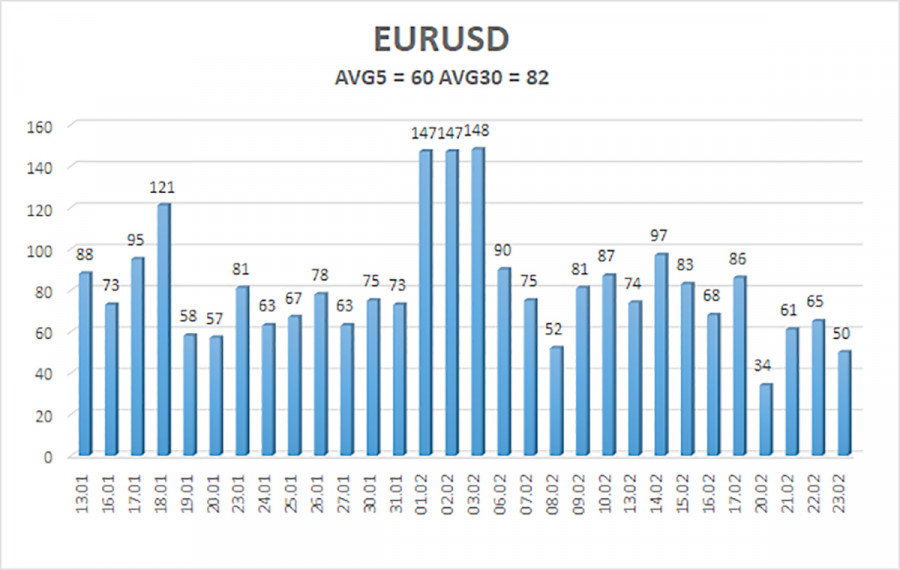

On Thursday, the EUR/USD currency pair maintained its rather weak downward trend. Although corrections continue to occur frequently, the pair is not losing much daily. On the other hand, it happens virtually daily and steadily. Recall that following a several-month increase of about 1,500 points, we have frequently warned that the European currency is severely overbought. Sincerely, there weren't any fundamental causes for this increase. There was another trend, a downward one that lasted two years, right before this one. Understandably, a correction of at least 400 points was required following such a significant and protracted downward trend. So we succeeded. The pair recovered 50% of its losses from the downward trend, raising the question: why should the euro continue to rise? While the ECB and Fed both raise rates at the same time, the Fed does it more quickly and forcefully. In other words, the dollar side is where this advantage lies. 90% of the time, the US economy won't experience a recession, but the EU economy could still get caught in a "trap." The US is experiencing a harsher, faster, and longer decline in inflation than the EU. The Fed's continued use of tough and aggressive rhetoric benefits the US currency as well. As a result, practically all factors continue to be in favor of the US dollar, which has declined significantly over the past six months. And now it has a legitimate reason to recoup its losses.
Nevertheless, on the 24-hour TF, the pair figured out the Senkou Span B line, which we've discussed numerous times. The 38.2% Fibonacci level is 1.0609 as well. The fall might continue since there hasn't been a rebound from these supports yet. And if it persists, the pair runs the risk of dropping to prices of $1.03 and $1.02. This means that the euro may be priced similarly to the dollar within the next month. Except for the senior linear regression channel, all indicators on the 4-hour chart point downward. As a result, the downward trend continues and is not cause for concern. Even the CCI indicator cannot enter the oversold area and create a warning signal regarding an upward reversal since the downward movement is too weak.
The "moderately hawkish" Fed policy.
As we've already stated, in general, we don't think the Fed minutes are a big deal. Rarely do they contain crucial information, but they occasionally do. That was not the case on Wednesday night. The only thing worth mentioning is the regulator's monetary committee's continued "hawkish" stance, which still aims to raise the rate without pausing. However, as it turned out, several committee members decided to endorse a 0.5% rise all at once at the previous meeting. They certainly remained the minority, though. We feel that this fact should not mislead traders, because, for example, in the last three meetings of the Bank of England, two out of nine committee members voted against tightening. Even still, the rate continues to rise by 0.5% as 7 additional members support them. As a result, unless there is "more than half" of them, "a few officials voting for 0.5%" in the United States do not matter. Also, the likelihood of this decreases with each meeting. Even so, the rate is still increasing by 0.25%. Yet, it is already 4.75%. Even if inflation slows down, it will eventually stop growing.
We, therefore, think that it will grow by a quarter point for however long it takes, rather than a predetermined number of times as many experts prefer to forecast. We think the Fed will respond to each inflation report and take appropriate action. For instance, we can already predict that the rate will rise by 0.25% in March with a 100% likelihood. Only a 0.1% yearly decline in inflation in January was unsatisfactory to the regulator. As a result, additional tightening is necessary.
The public debt and its ceiling were also discussed in the protocol, which may soon cause the financial system to run into them once more. It is noteworthy that at least twice a year, a new season of the series "raising the debt ceiling in the United States" is released. And each time, the corresponding conclusion is reached following a protracted debate in Congress and the Senate. As a result, we think that this is rarely a problem and not even worth paying attention to. The key rate is expected to rise consistently throughout the first half of 2023, thus the dollar is still growing steadily. We think that the euro/dollar pair can decline for a few days in relative calm.

As of February 24, the euro/dollar currency pair's average volatility over the previous five trading days was 60 points, which is considered to be "normal." Thus, on Friday, we anticipate the pair to move between 1.0525 and 1.0645 levels. A new round of correction will be signaled by the Heiken Ashi indicator's upward movement.
Nearest levels of support
S1 – 1.0498
S2 – 1.0376
S3 – 1.0254
Nearest levels of resistance
R1 – 1.0620
R2 – 1.0742
R3 – 1.0864
Trade Advice:
The EUR/USD pair is still moving downward. Unless the Heiken Ashi indication turns up, you can continue to hold short positions with targets of 1.0525 and 1.0498. If the price is fixed above the moving average line with a target of 1.0742, long positions can be opened.
Explanations for the illustrations:
Determine the present trend with the use of linear regression channels. The trend is now strong if they are both moving in the same direction.
The short-term trend and the direction in which to trade right now are determined by the moving average line (settings 20.0, smoothed).
Murray levels serve as the starting point for adjustments and movements.
Based on current volatility indicators, volatility levels (red lines) represent the expected price channel in which the pair will trade the following day.
A trend reversal in the opposite direction is imminent when the CCI indicator crosses into the overbought (above +250) or oversold (below -250) zones.